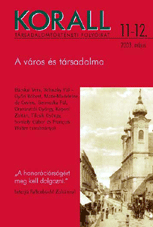Bevándorlás és befogadás a dunántúli városokban a 19. század első felében. A bevándorlók esélyei a polgárjog elnyerésére
Immigration and Integration in the Transdanubien Towns in the firs half of the 19th Century
Author(s): Vera BácskaiSubject(s): History
Published by: KORALL Társadalomtörténeti Egyesület
Keywords: social history; urban history; Hungary; 19th century; Transdanubia; immigration; integration; local politics; market place; citizenship
Summary/Abstract: The study examines in the case of five Transdanubian towns – the free royal towns of Kőszeg, Sopron and Székesfehérvár and the manorial towns Nagykanizsa and Szombathely – the reception and integration of the narrower group of those immigrants that gained civic rights in the first half of the 19th century. The study establishes that concerning the chance of integration of immigrants, in the practice of donating citizenship there was a significant difference depending on whether the town management increased or limited the number of citizens accepted, moreover, whether individual towns preferred locals or gave more chance to immigrants. With the exception of Székesfehérvár, which attracted immigrants from broader regions of the country, the great majority came from the immediate neighbourhood of towns. An increasing number of new citizens came from towns or market towns, again with the exception of Fehérvár. The professional composition of new citizens was in accordance with the international experience, namely artisans and traders, that is, skilled people, made up the majority in these towns. Contrarily to this tendency, the number of primary producers significantly rose in Székesfehérvár in the first half of the century. By analysing data, the author arrives at the conclusion that concerning the integration of immigrants by donating them citizenship, two models can be sketched. Kőszeg, Nagykanizsa and Szombathely belong to the first, since these towns were open to immigrants and broadened the ranks of the middle class primarily by receiving immigrants of civic professions. Sopron and Székesfehérvár represent the other model, which preferred locals and primary producers and rendered the integration of immigrants more difficult.
Journal: Korall - Társadalomtörténeti folyóirat
- Issue Year: 2003
- Issue No: 11-12
- Page Range: 103-110
- Page Count: 8
- Language: Hungarian

